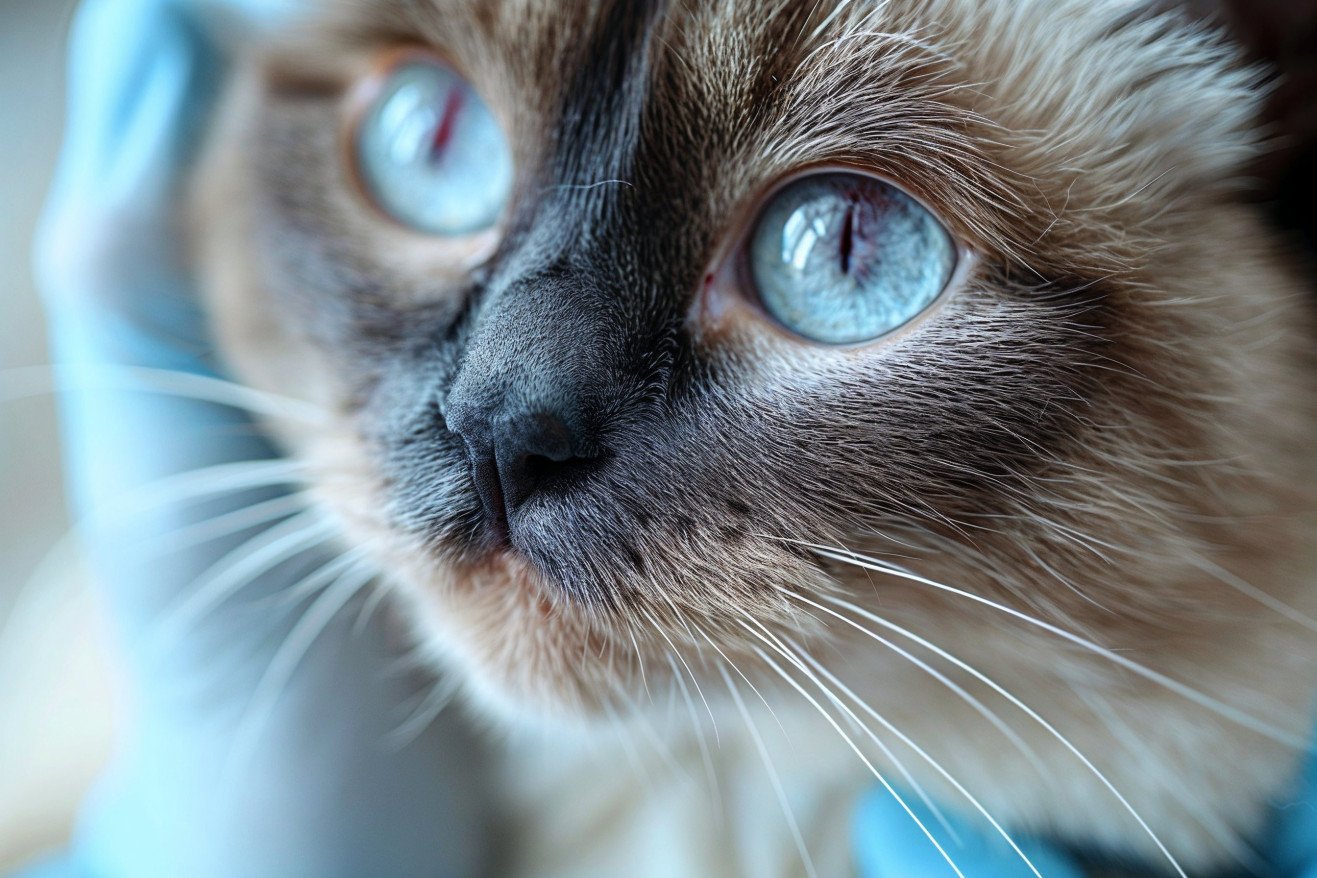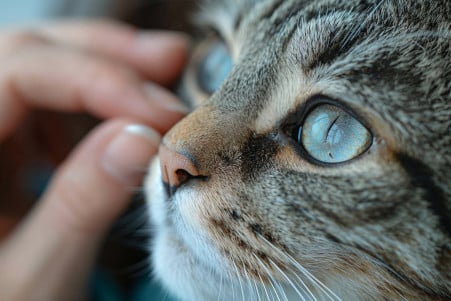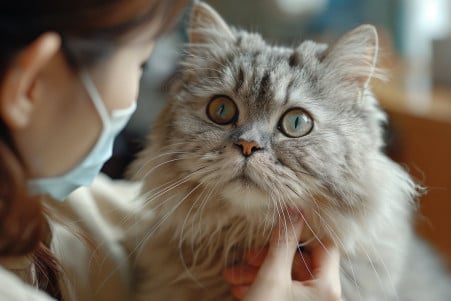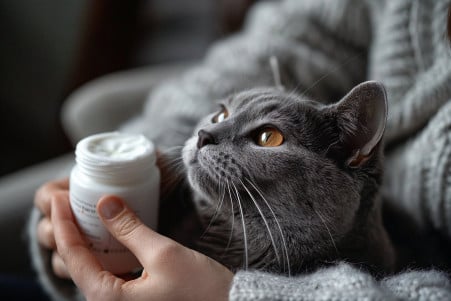What Is Cherry Eye in Cats? Causes, Treatment, and More
28 March 2024 • Updated 27 March 2024

If you've noticed a pink, swollen mass sticking out from the corner of your cat's eye, you may be dealing with cherry eye. But what is cherry eye, and how can it be treated? Cherry eye in cats is a prolapsed gland from the third eyelid that appears as a reddish-pink fleshy mass. It occurs when the gland that produces tears becomes inflamed and swells, popping out from its normal position. Although it can be distressing to see, cherry eye is generally harmless as long as it's addressed by a vet as soon as possible.
To help you better understand this common feline eye condition, we've summarized the latest research and clinical findings from veterinary ophthalmologists on the causes, risk factors, diagnosis, and treatment options for cherry eye. By the end of this article, you'll have a deeper understanding of the condition and know exactly how to recognize and manage cherry eye to keep your cat's eyes healthy.
What causes cherry eye in cats?
Symptoms and Diagnosis: How to Tell If Your Cat Has Cherry Eye
The most common sign of cherry eye is a pink or red swelling that comes out from the inner corner of your cat's eye. This swelling is the prolapsed third eyelid gland, which has moved out of place. Other symptoms to look out for include watery eyes or discharge, squinting, and scratching or rubbing the eye, which may indicate that the eye is irritated or painful.
To diagnose cherry eye, your vet will conduct a comprehensive physical examination of your cat's eye and assess the third eyelid. According to Forever Vets, other tests such as tonometry to measure the pressure in the eye or a Schirmer tear test may be performed to check for other issues like dry eye. In some cases, your vet may also need to use eye stains or imaging tests to rule out other eye problems or complications.
If you think your cat has cherry eye, it's important to get them to the vet as soon as possible. As Joii Pet Care points out, early treatment and diagnosis can prevent the prolapsed gland from getting worse, more inflamed, and more irritated from the rubbing. If left untreated, cherry eye can also lead to infection or a loss of tear production, which can cause vision problems in the future. By catching the symptoms early and getting your cat diagnosed by a vet, you can make sure that they get the treatment they need to protect their vision and eye health in the long term.
Surgical Treatment: The Standard Approach for Correcting Cherry Eye
The most common treatment for cherry eye in cats is surgery to reposition the prolapsed third eyelid gland. As explained by South Texas Veterinary Ophthalmology, the most frequently used surgical method is the 'pocket technique,' which involves repositioning the gland and anchoring it in place. This surgery is generally very successful, with approximately 90% of cases resolving after the first surgery.
Aftercare is important and often includes the use of antibiotics, anti-inflammatories, and sometimes eye drops to promote healing and prevent infection, according to Vet Professional - Eye Vet. However, there is still a risk of complications, including the gland popping back out, infection, or inflammation, all of which may require further treatment or a second surgery.
Although surgery is the gold standard for treating cherry eye, Animal Eye Care warns that it is important to make sure the gland is properly repositioned because if it isn't, it can lead to other issues, including conjunctivitis, corneal ulcers, or dry eye. It's important to seek veterinary care as soon as possible and follow all aftercare instructions to ensure the best outcome and protect the long-term health of the affected eye.
How to Treat Cherry Eye Without Surgery
Although surgery is the only way to fully treat cherry eye, there are some temporary ways to treat the condition before and after surgery. According to WikiHow, anti-inflammatory eye drops or ointments can be used to help reduce swelling and irritation in the short term. Keeping the eye area clean and using warm compresses can also help soothe the eye and prevent further irritation.
There are also some natural supplements that can be used to help reduce inflammation and fight bacteria, including supplements that contain turmeric and other herbs. However, these should only be used under the guidance of a vet, according to NHV Natural Pet. Meanwhile, Cats.com advises against using home remedies or over-the-counter treatments, as they can make it harder for vets to diagnose and treat the condition.
Although some of these treatments may provide temporary relief, it's important to see a vet as soon as possible and follow their instructions closely to ensure that you're able to treat cherry eye effectively and avoid any complications.
Potential Risks and Long-Term Effects of Untreated Cherry Eye
If cherry eye is not treated, it can result in a number of risks and long-term consequences for a cat’s eye health and vision. According to Wagwalking.com, the prolapsed gland may become inflamed, infected, or develop corneal ulcers, all of which can cause pain and may even lead to vision loss. In addition, the gland may eventually become nonfunctional, causing a reduction in tear production and leading to dry eye, which will need to be managed with medication and regular check-ups.
As mentioned by CARE Vets, if a cherry eye is large and goes untreated, it may prevent the eye from closing properly, which can lead to further damage to the cornea and potential vision loss. The Anicira organization stresses that early veterinary intervention is important to prevent these risks and ensure the eye’s long-term health and functionality.
The risks of not treating cherry eye are significant, so it’s important to get professional help as soon as possible to make sure your cat’s vision and overall eye health are protected.
Recovery and Aftercare: Ensuring a Successful Outcome
Following surgical repair, cats generally need a recovery period of 1-2 weeks with limited activity and close observation, according to the Swan Veterinary Hospital. Postoperative treatment often includes antibiotics, anti-inflammatory drugs, and eye drops to promote healing and prevent infection, according to the Vet Professional - Eye Vet. An Elizabethan collar or similar device may be needed to keep the cat from scratching or otherwise bothering the surgery site.
Regular check-ups with the vet will be needed to make sure the eye is healing and the gland is staying in place, according to the South Texas Veterinary Ophthalmology. Good aftercare and following the vet's instructions are important for a successful recovery and to reduce the chances of complications or reoccurrence. With the right focus on aftercare, cat owners can make sure their cat's eyes stay healthy and there are no long-term vision problems.
Conclusion: Why It's Important to Prioritize Your Cat's Eye Health
Cherry eye is a treatable condition, but prompt veterinary attention and proper treatment are essential to prevent potential complications and long-term effects. While surgery is the recommended approach, effective management and aftercare are crucial for a successful outcome and preserving the cat's eye health.
Responsible pet ownership involves being aware of potential health issues like cherry eye and taking proactive steps to address them. Regular eye examinations and consultations with a veterinarian can help catch and address any eye-related concerns early on. By prioritizing their feline companion's eye health, cat owners can ensure a better quality of life and prevent vision impairment or discomfort.


